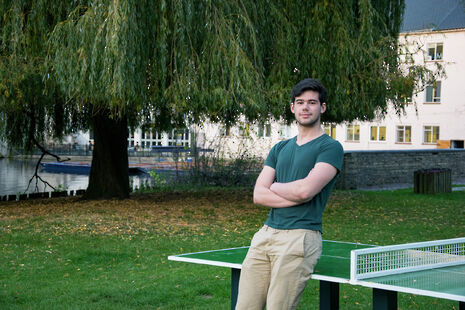BPPV is common, yet commonly overlooked
Keir Baker opens up about a one-in-ten condition which is all too frequently ignored

I tilt my head. The world spins in a clockwise direction, twice, ad infinitum. The feeling of nausea and a dull pain in my head begins to build. It feels like it just won’t stop and I am scared.
I move my head back. The world – to my great relief – returns almost immediately back to normal. Any discomfort I had felt resides, yet the threat of that awful experience still lingers, restricting my life in a variety of ways.
I suffer from an affliction called Benign Paroxysmal Positional Vertigo (BPPV). It is one of the most common causes of vertigo – the sensation that you, or the environment around you, is moving and spinning – and its symptoms tend to be particularly intense and distressing. BPPV is also far more prevalent than the level of publicity surrounding it would suggest: 30 per cent of the UK population will have experienced it before they reach the age of 70, and research by the American Academy of Physical Medicine and Rehabilitation found that nine per cent of 198 young Americans aged between 18 and 34 unknowingly suffer from it.
Worryingly, too, it is often misdiagnosed by GPs or wrongly ignored by sufferers, many of whom falsely attribute it to stress or a migraine. And in extreme examples, some with the affliction – including myself – have been sent for traumatic MRI scans to search for non-existent brain tumours. There is no cure, only management techniques.
First properly identified by Robert Barany in 1921, BPPV is also fascinating from a scientific perspective for a variety of reasons. For one thing, the actual process that causes the symptoms sheds light on the complexity of the labyrinthine structure that is the human ear. Within the main chamber of the ear – known as the utricle – lie embedded in a gel-like substance minute crystals of calcium carbonate – known as otoconia. For the vast majority of the population, that is where they remain. But for sufferers of BPPV, the otoconia have been dislodged and allowed to migrate into one of three semi-circular canals adjacent to the chamber. Within these canals are sensors that send messages to the brain in reaction to head rotations or movements, and the symptoms of BPPV are caused by the dislodged otoconia interfering with these sensors. When a sufferer tilts their head into the aggravating position, the spinning results from the free-moving crystals ‘knocking’ against them.
Interestingly, researchers are still at a loss as to how the otoconia become displaced. A number of different theories have been put forward, none of which are backed up by empirical evidence. Indeed, I personally conform to a number of them: a head injury resulting from a misjudged game of British Bulldog on a concrete playground; a tendency for inner-ear infections like labyrinthitis; a potential genetic link; and a lifestyle of high stress and little sleep all may have contributed to the dislocation of my otoconia.
Scientists have also struggled to identify any way in which BPPV might be fully cured. The crystals are too microscopic to remove via an operation and there is no known drug that could counteract their effects. I have thus come to accept it as an affliction that I will have to deal with my entire life, potentially impacting on my ability to enjoy playing some sports (particularly as a goalkeeper) and sleep in certain positions.
But there are management techniques that, if done at regular intervals, can nullify the symptoms, to prevent BPPV from having any significant impact on the lives of sufferers. For example, the easy-to-perform ‘Epley manoeuvre’, which involves a practitioner helping to manipulate the patient’s head and body in an effort to relocate the crystals back to the utricle, has a success rate of around 80 per cent. Though the process can be quite traumatic – the reposition inevitably triggers dizziness at a very intense level – it provides much-needed relief from the symptoms to the extent that life feels effectively normal.
BPPV is therefore scientifically very interesting and a condition that continues to receive in-depth research and examination. Practically speaking, though, it is an illness that needs more public awareness and understanding, particularly for students who may erroneously dismiss it as the result of stress, tiredness, and a work-intensive university lifestyle.
BPPV and similar conditions are particularly disruptive in a Cambridge context, with our short and intense eight-week terms. Given that BPPV has symptoms that can cause significant physical and psychosocial limitations if left untreated, I hope that increasing awareness of its existence could prevent others from suffering the panic, confusion and worry of their studies being affected by an unknown and unsettling affliction that they cannot find a way to resolve
 News / Uni members slam ‘totalitarian’ recommendation to stop vet course 15 January 2026
News / Uni members slam ‘totalitarian’ recommendation to stop vet course 15 January 2026 Science / Why smart students keep failing to quit smoking15 January 2026
Science / Why smart students keep failing to quit smoking15 January 2026 Comment / Will the town and gown divide ever truly be resolved?12 January 2026
Comment / Will the town and gown divide ever truly be resolved?12 January 2026 Features / How sweet is the en-suite deal?13 January 2026
Features / How sweet is the en-suite deal?13 January 2026 Interviews / The Cambridge Cupid: what’s the secret to a great date?14 January 2026
Interviews / The Cambridge Cupid: what’s the secret to a great date?14 January 2026










